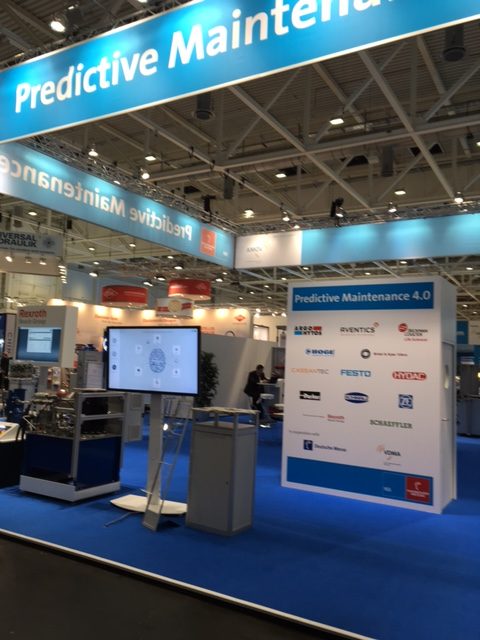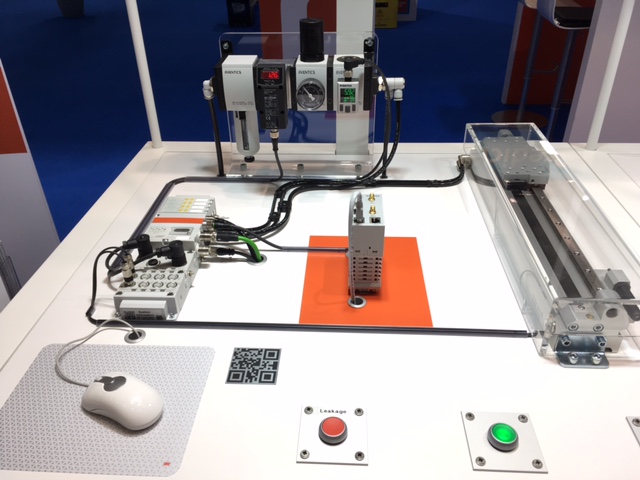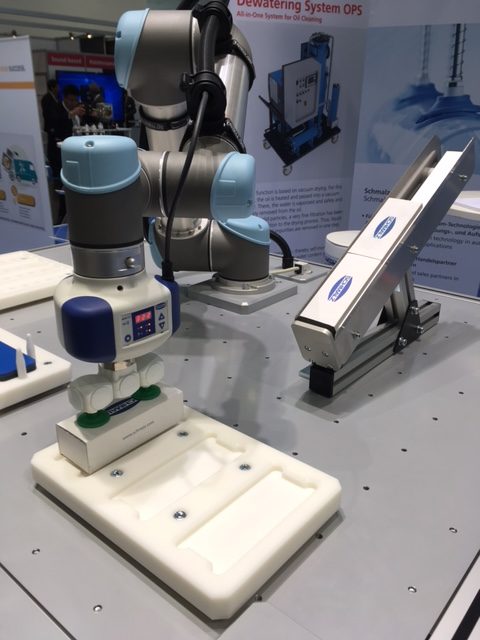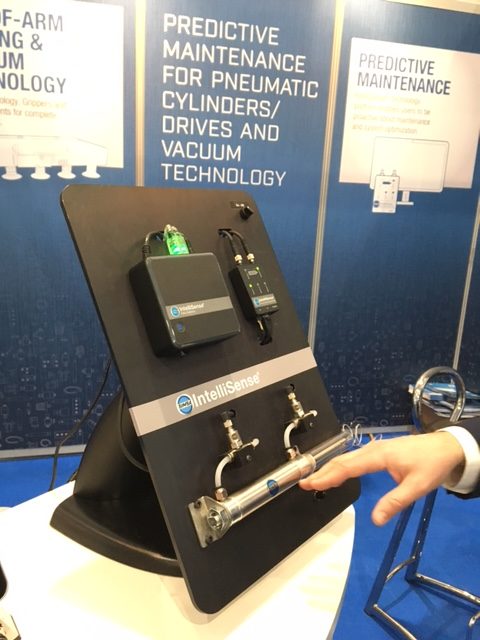
Predictive maintenance display at Hannover
Moving beyond simple preventive maintenance for fluid-power systems, more than a dozen companies are looking to the future in a special Predictive Maintenance 4.0 exhibit at the Hannover Fair. The goal is not only to monitor the condition of machines and note anomalies, but also to use analytics and cloud-based systems to determine the remaining life of components as per Industry 4.0. This not only avoids catastrophic failures, it also saves money by not replacing parts prematurely.
Aventics displayed a motion-control application that monitors shock absorber functions and cylinder speeds based on an electropneumatic valve system. Existing sensors in the system are monitored via the controls and sensor data are analyzed with AV/AES Series valves and the Smart Pneumatics Monitor—a specially developed add-on module for the AES valve electronics.
Monitoring the load lets the system determine the current state of the shock absorber and detect wear early on. And information is sent to the user in standard OPC-UA data logs.

Aventics motion application
Boge Kompressoren, a partner company of Aventics, demonstrated how “intelligent” pneumatics can improve efficiency and reduce compressed-air losses. Aventics provides sensor data with information on a system’s operation and its air consumption in standard OPC-UA format. From that, Boge can optimize an entire compressed air system and even predict when a compressor needs to start, just before demand increases.
“The advantages of predictive maintenance are nothing new to us,” said Dieter Michalkowski, a global account manager at Aventics. “But the IoT has now made it possible to generate the information required for predictive maintenance that really lives up to its name.”
Predictive maintenance with intelligent data analyses is now considered an important value driver in the industrial sector as it can prevent unplanned machine downtime and increase system availability. In addition, maintenance costs are reduced because only the components that reach the end of their life are replaced.

Schmalz CobotPump
Schmalz exhibited its new CobotPump as part of a robot’s end-of-arm tooling. The CobotPump is part of the company’s new generation of “intelligent” vacuum generators that do not require compressed air, and have an integrated interface for gripper systems and robot connections.
A control and data interface via IO-Link enable process monitoring and predictive maintenance from the machine to the cloud. Condition-monitoring capabilities recognize deviations to reduce errors and downtime and an NFC interface features direct access to processes and device via a smartphone.
The device also boasts high energy efficiency due to integrated control and performance adjustments that are adapted to the handling process, and on-board parameterization is possible via NFC or IO-Link. The data interface of the CobotPump delivers all relevant data to a SICON Gateway, which aggregates and interprets data from production processes and provides visual information independent of platform or manufacturer.
The generator is suitable for airtight and slightly porous workpieces, and it can be used for mobile robotics and automated handling of small parts, as well as stationary handling tasks. Suction capacity is up to 12 lpm.

Bimba IntelliSense predictive maintenance
Bimba displayed the IntelliSense Sensor Interface Module in action. The remote-monitoring device connects to cylinder sensors and reports data including cylinder condition, stroke time, end of travel, pressure and temperature. Data can be sent to a PLC for alarming and control, and it can also send real-time information to a PC or IntelliSense Data Gateway for remote monitoring, data logging and analytics. IntelliSense was available for Bimba cylinders, and the company recently added the capabilities to its Vaccon vacuum generators.
3DSignals has taken a new approach to machine fault detection with a cloud-connected ultrasonic microphone that reportedly reduces unplanned downtime and helps avoid critical failures. One or more microphones are installed near a critical device like a pump or valve. The unit’s Predisound platform collects sounds and data from industrial equipment, screens out background noise, identifies anomalies, classifies patterns of equipment failure and predicts issues before they interrupt production.
Unlike devices like vibration sensors, there is no intrusion or contact with the device, set-up is quick and it covers a larger area with fewer sensors. The system uses real-time embedded Linux and a standard power-over-Ethernet interface, and sensing range is from 10 cm to 5 m.
Filed Under: Pneumatic Tips, Slider